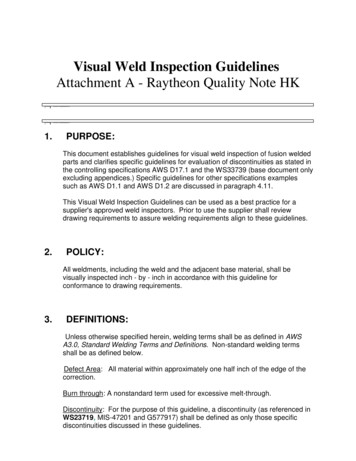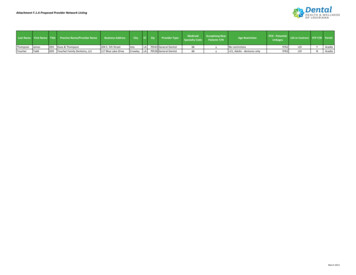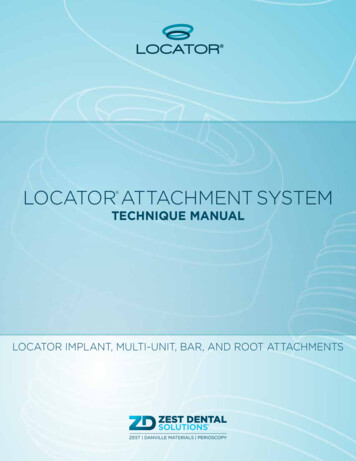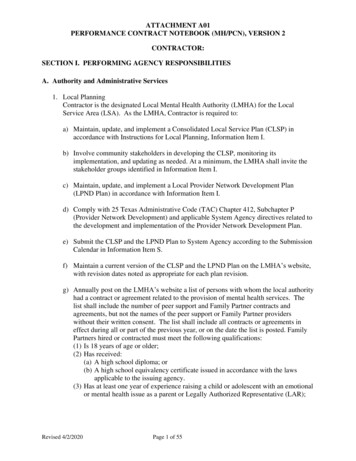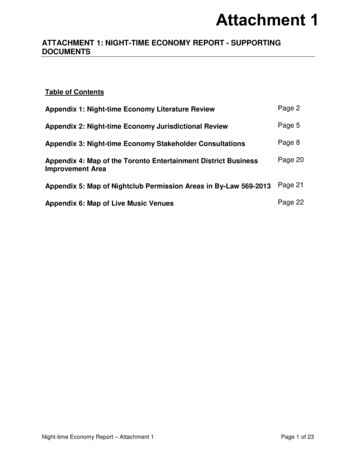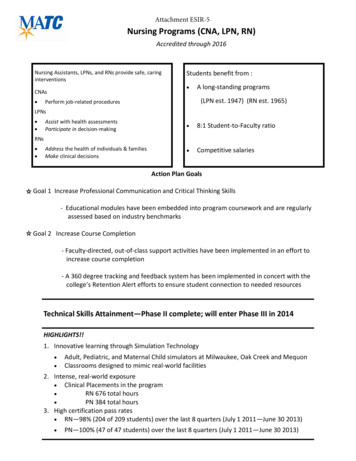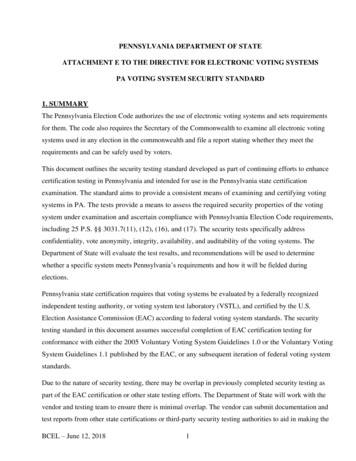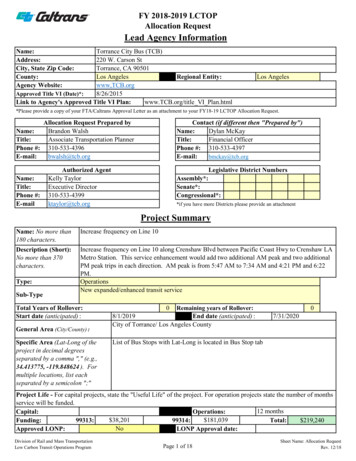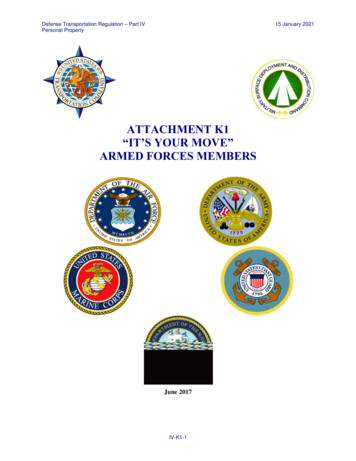
Transcription
Defense Transportation Regulation – Part IVPersonal Property15 January 2021ATTACHMENT K1“IT’S YOUR MOVE”ARMED FORCES MEMBERSJune 2017IV-K1-1
Defense Transportation Regulation – Part IVPersonal Property15 January 2021TABLE OF CONTENTSATTACHMENT K1 “IT’S YOUR MOVE” ARMED FORCES MEMBERS . K1-1A.Who Is This Attachment For? . K1-3B.What’s New in This Attachment? . K1-3C.Defense Personal Property Program . K1-3D.Defense Personal Property System . K1-3E.Introduction. K1-4F.Valuable Tips . K1-4G.Weight Allowances . K1-5H.Motorcycle or Dirt Bike Shipments . K1-8I.Consumable Items. K1-9J.Professional Books, Papers, and Equipment (PBP&E/Pro-Gear). K1-9K.When to Make Arrangements . K1-11L.Who to See . K1-11M.What You “May” Ship As HHG . K1-11N.What You “May Not” Ship as HHG . K1-12O.Prevent Pest Infestation . K1-12P.Alcoholic Beverage Shipment . K1-13Q.Shipping and or Storing Your POV . K1-14R.Unaccompanied Baggage (UB) . K1-14S.Boats . K1-14T.Firearms . K1-16U.Arranging the Move . K1-17V.Documentation . K1-17W.Responsibilities . K1-18X.Claims for Loss and Damage FRV . K1-22Y.Inconvenience Claims . K1-24Z.During and After the Move . K1-24AA.Personally Procured Move (PPM) . K1-25BB.Storage . K1-28CC.Transportation of Unauthorized HHG Articles . K1-29DD.WebSites to Visit . K1-29IV-K1-2
Defense Transportation Regulation – Part IVPersonal Property15 January 2021A. WHO IS THIS ATTACHMENT FOR?This attachment was created to assist Armed Forces Members (Army, Navy, Air Force, Marine Corpsand United States (U.S.) Coast Guard). It helps you understand your allowances and responsibilitiesinvolving the shipment and or storage of your household goods (HHG) and unaccompanied baggage(UB). This policy directive has been reviewed by the Per Diem, Travel and TransportationAllowance Committee (PDTATAC) according to Department of Defense (DoD) Directive 5154.29,DoD Pay and Allowances Policy and Procedures, as PDTATAC Case RR090630. Any conflictbetween this directive and the Joint Travel Regulations (JTR) is resolved based on the JTR and notthis directive.B. WHAT’S NEW IN THIS ATTACHMENT?1. The Defense Personal Property Program (DP3), Defense Personal Property System (DPS), FullReplacement Value (FRV) protection in the event you suffer loss and or damage to your personalproperty and Customer Satisfaction Survey (CSS) requirements just to name a few.2. The contents contained in this attachment are not all inclusive of allowances. For detailedService specifics, consult your Service regulations. For uniformed member allowances, consultthe JTR. For further information, contact your local Transportation Office (TO).3. For shipments from the United States to overseas (export) or shipments from overseas to theUnited States (imports), if you would like to request that certain Personally IdentifiableInformation (PII) on the TSP vessel manifest not be shared or made available to the public per 19CFR 103.31, complete a Vessel Manifest Confidentiality Request form located athttp://www.move.mil/ under the “Moving Guide” section. Click on “Overseas Moves(OCONUS)” and then download the “Vessel Manifest Confidentiality Request Form”. Oncecompleted, send the form to the email address identified on the form. An approval can take up to90 days to process, but once approved, it is good for 2 years.C. DEFENSE PERSONAL PROPERTY PROGRAM1. To improve your moving experience and streamline the process for those who support it, the DoDdeveloped a new program called the “Defense Personal Property Program (DP3).” This newprogram focuses on meeting the needs of Armed Forces Members, DoD Civilian Employees andtheir families by promoting a higher service quality.2. The backbone of the DP3 is the DPS, which automates and simplifies your personal propertymove process.D. DEFENSE PERSONAL PROPERTY SYSTEM1. As a centralized, integrated system, DPS supports the DP3 as the one-stop source for managingpersonal property moves. For the first time, the United States Transportation Command hasoversight of claims and Transportation Service Provider (TSP) information in one convenientlocation. In addition, DPS provides the convenient 24/7 access to personal property shipmentinformation and a conduit for a direct relationship between DoD customers and TSPs throughoutthe entire moving process.2. Some highlights of DPS include the ability of DoD customers to use DPS to settle claims directlyonline with their TSP. Claims protection includes FRV of lost items and/or items damagedbeyond repair, direct communications and claims settlement between the customer and the TSP.DPS is the focal point for all DoD customers, TSPs, Personal Property Shipping Offices (PPSOs),the Service Headquarters (HQ), TOs, and others who participate in the personal property movingprocess.IV-K1-3
Defense Transportation Regulation – Part IVPersonal Property15 January 20213. Accessing DPS:a. First-time DPS users must obtain a Transportation Enhancement Access ManagementServices (TEAMS) login Identification (ID) and password before accessing DPS.b. To obtain a TEAMS login ID and password, go to http://www.move.mil .c. Once you have accessed Move.mil, click on the “create a new account” link located in thegreen banner.d. The DPS User Registration page will appear.e. Complete the registration, if you are attaching a certificate ensure you use attach theAuthentication. Select Register when completed.f.DPS User Registration Status will display confirming your account was created.g. You will receive an email from TEAMS advising your request for access to DPS has beenapproved, along with instructions on how to log into DPS for the first time.E. INTRODUCTION1. A successful move is not a matter of chance. It is the result of planning and hard work. At thecenter of these efforts is you, the customer. If you expect a good move, you must play an activerole.2. This attachment has been prepared to help you understand your allowances and responsibilitiesconcerning the shipment and or storage of HHG and/or UB. It is also intended to help youunderstand your allowances and responsibilities in the event you have to file a claim for lossand/or damage.3. For additional DPS user and personal property shipping information, please visithttp://www.move.mil or contact your local PPSO, TO, or Personal Property Processing Office(PPPO). Additional websites are listed at the end of this attachment.4. Your new unit may assign you a sponsor who should contact you some weeks in advance of yourreporting date. A sponsor can often provide information helpful to you in arranging a smoothmove. Contact your new unit if you have not heard from your sponsor within a reasonableperiod. It is your move. Ask questions. Read and understand what you sign. Get involved.F. VALUABLE TIPS1. Have expensive and valuable items (e.g., artwork, collectibles, heirlooms) appraised. TheGovernment does not pay for the appraisals, but consider this part of your investment in the eventof loss or damage. Attempt to locate original purchase receipts for your more expensive itemsand keep them separate from the rest of your shipment. Consider using a video camera or takingclose-up pictures to record the condition of your furniture, working condition of your stereo,television and the actual appearance of your expensive and/or valuable items prior to the HHGpack/pickup dates. This could help in the event you must file a Loss/Damage Claim.2. Do not ship small, extremely valuable items such as stocks, bonds, jewelry, coins/coincollections, and items of great sentimental value such as photo albums. Pack them in yoursuitcases and hand-carry them, as well as your purchase receipts, pictures, and appraisals.3. Protecting Your PII on International Shipments. Public Law allows for certain data elements onan ocean vessel manifest that may contain PII to be shared with parties outside the DoD. Toprotect your PII, visit http://www.move.mil/, select “Moving Guide”, and click on “OverseasMoves (OCONUS)”, and then download the “Vessel Manifest Confidentiality Request Form”.IV-K1-4
Defense Transportation Regulation – Part IVPersonal Property15 January 2021Once completed, send it to the email address identified on the form. Approvals can take up to 90days to process, but once approved, it is good for 2 years.4. Tipping and/or supplying meals, snacks, or other refreshments to moving companyrepresentatives is discouraged. Providing monetary tips and meals as a “cost of doing business”sets unrealistic demands on service members and civilian employees least capable of providingthis “service.” Please report any TSP requesting or requiring a tip to your Joint Personal PropertyShipping Office (JPPSO) for possible punitive actions.G. WEIGHT ALLOWANCES1. The JTR prescribes the maximum Permanent Change of Station (PCS) and Non-TemporaryStorage (NTS) weight allowances that you can ship and/or store at Government expense based onthe member’s rank and dependency status. The JTR also prescribes Temporary Duty (TDY)weight allowance based on the member’s rank. Weight allowances do not include ProfessionalBooks, Papers and Equipment (PBP&E/PRO-Gear) or required medical equipment.NOTE: The Secretary concerned may authorize a higher weight allowance (not to exceed [NTE]18,000 pounds) of a member below pay grade O-6, but only on a case-by-case basis. TheSecretary may increase the member's PCS weight allowance if the Secretary determines thatfailure to increase the member's weight allowance would create a significant hardship to themember or the member's dependentsPCS and NTS Weight Allowance (Pounds)Grade NOTE 1/NOTE 3With DependentsNOTE 2Without DependentsOfficer Personnel0-10 to ervice Academy Graduates12,00010,000Enlisted PersonnelE-915,000 Note 413,000 Note 0007,000E-48,0007,000E-3 to E-18,0005,000Aviation Cadets8,0007,000Service Academy Cadets/Midshipmen350NOTE 1: Includes a Uniformed Service regular and Reserve Component member, and anofficer holding a temporary commission in the U.S. Army/Air Force.NOTE 2: For this table, a member “with dependents” is a member who has a dependenteligible to travel at Government expense incident to the member’s PCS. Actual dependenttravel has no bearing. Incident to a member’s first PCS after:1. The death(s) of all of the member's dependent(s), orIV-K1-5
Defense Transportation Regulation – Part IVPersonal Property15 January 20212. A divorce that leaves the member with no dependent(s) eligible to travel atGovernment expense, the member has the weight allowance of a member “withdependents”.NOTE 3: A member appointed from an:1. Enlisted/warrant officer grade to a commissioned officer grade, or2. Enlisted grade to a warrant officer grade or rating is authorized the grade’s weightallowance:a. Held on the member's PCS authorization/order effective date used for HHGtransportation, orb. From which an appointment was accepted, whichever is greater.3. Upon reversion, the member is authorized the weight allowance of the grade held:a. On the member's PCS authorization/order effective date then being used forHHG transportation, orb. Before reversion, whichever is greater.NOTE 4: A member selected as Senior Enlisted Advisor to the Chairman of the Joint Chiefsof Staff, Sergeant Major of the Army, Chief Master Sergeant of the Air Force, Master ChiefPetty Officer of the Navy, Sergeant Major of the Marine Corps, or Master Chief Petty Officerof the Coast Guard is authorized a weight allowance of:1. 17,000 pounds with dependents or,2. 14,000 pounds without dependents.for a PCS authorization/order issued on or after receiving notice of selection to that positionand for the remainder of the military career.TDY WEIGHT ALLOWANCES (POUNDS)Service and Grade NOTE 1Army, Air Force, and MarineCorpsNavy, Coast Guard, and National Oceanicand Atmosphere Administration CorpsPublic Health ServiceWeightAllowanceOfficer PersonnelGeneral/General of the ArmyAdmiralN/A2000 NOTE 2Lieutenant GeneralVice AdmiralSurgeon General1500Major GeneralRear Admiral (upper half)Deputy/Assistant SurgeonGeneral1000Brigadier GeneralRear Admiral (lower half)Assistant Surgeon General1000ColonelCaptainDirector800Lieutenant Colonel/Warrant Officer (W-5)Commander/Warrant Officer (W-5)Senior800Major/Warrant Officer (W-4)Lieutenant Commander/Warrant Officer (W-4)Full800Captain/Warrant Officer (W-3)Lieutenant/Warrant Officer (W-3)Senior Assistant600First Lieutenant/ContractSurgeon/Warrant Officer (W-2)Lieutenant (Junior Grade)/Warrant Officer (W-2)Assistant600Second Lieutenant/OfficerGraduate of ServiceAcademy/Warrant Officer (W-1)Ensign/Officer Graduate of ServiceAcademy/Warrant Officer (W-1)Junior Assistant600Enlisted PersonnelE-9E-9N/A600 NOTE 3E-8E-8N/A500E-7 to E-1E-7 to E-1N/A400Aviation CadetAviation CadetN/A400IV-K1-6
Defense Transportation Regulation – Part IVPersonal PropertyService AcademyCadet/Midshipman15 January 2021Service Academy Cadet/MidshipmanN/A350NOTE 1: Includes a Regular member, a member of a Uniformed Service Reserve Component,and an officer holding a temporary commission in the Army/Air Force of the United States.NOTE 2: The Secretarial process may authorize additional weight up to 2,000 pounds (up to4,000 pounds total) for the Chiefs of Staff, U.S. Air Force and U.S. Army, the Chief of NavalOperations, the Commandant of the Marine Corps, and the Commandant of the Coast Guard.NOTE 3: A member selected as Senior Enlisted Advisor to the Chairman of the Joint Chiefs ofStaff, Sergeant Major of the Army, Master Chief Petty Officer of the Navy, Master Chief PettyOfficer of the Coast Guard, Chief Master Sergeant of the Air Force, or Sergeant Major of theMarine Corps, who requires a TDY weight allowance of HHG, is authorized a weight allowance of800 pounds for a TDY authorization/order issued on or after receiving notice of selection to thatposition and for the remainder of the military career.2. You, not your TO or TSP, are responsible for staying within your authorized weight allowance.If the weight of items packed, shipped, or stored exceeds your weight allowance, you arefinancially responsible for the payment of all charges connected with excess weight in accordancewith (IAW) your Service guidance/regulations.3. For this reason, estimating the weight of your HHG is very important. Estimates should startearly, even before you visit your TO or before you prepare your application to ship and or storepersonal property in DPS. The counselor at your TO requires an estimated weight for eachshipment you intend to make.4. An easy and usually dependable method for making this estimate is to figure 1,000 pounds perroom (not including storage rooms or bathrooms), then add the estimated weight of largeappliances and items in the garage, storage rooms, basement, etc. An optional method is to usethe “Weight Estimator” at https://www.move.mil/resources/weight-estimator.5. Weight Estimates Not Official:a. Weight estimates are not official; they are planning tools only. You can never use weightestimates to refute excess weight charges.6. Excess Weight Can Cost Big Money:a. Exceeding your authorized weight allowance on a move can cost you a lot of money.Charges for excess weight can range from several hundred to several thousand dollars.b. Notification of overweight charges can take many months after your move is completed. Fora member who is separating from the Service and no longer remains in an active pay status,excess costs should be paid prior to the movement of HHG. Excess costs are collected IAWService regulations. Contact your local TO for additional information regarding excess costs.7. Verify Accuracy of Excess Cost:a. The way to avoid excess weight charges is to stay within your authorized weight allowanceby estimating early and disposing of unnecessary possessions. When you receive anotification for exceeding your weight allowance, check it carefully. Often you may not havereceived credit for PBP&E/PRO-Gear. The estimated weight of PBP&E/PRO-Gear must bedeclared in MilMove or DPS.b. If you have any questions concerning your excess weight, contact your local TO.IV-K1-7
Defense Transportation Regulation – Part IVPersonal Property15 January 20218. Request for Reweigh:a. The TO at origin or destination can authorize a reweigh of your personal property shipment atyour request at no cost to you. This ensures a reweigh of your personal property is completedor scheduled prior to accepting delivery. If you are available when your shipment isreweighed, you have the right to witness the reweigh and/or request to see the reweigh ticketsfor verification.9. Overseas Weight Limitations:a. Some overseas areas impose administrative weight restrictions. If the area to which you areassigned provides Government furniture, for example, the Government may impose anadministrative weight restriction, which would prevent you from shipping your full JTRweight allowance overseas. In these cases, a member is limited to HHG transportation of2,500 pounds (net) or, 25 percent (net) of the member’s authorized weight allowancewhichever is greater, plus UB transportation. If both spouses are me
The Defense Personal Property Program (DP3), Defense Personal Property System (DPS), Full Replacement Value (FRV) protection in the event you suffer loss and or damage to your personal property and Customer Satisfaction Survey (CSS) requirements just to name a few. 2. The contents containe
